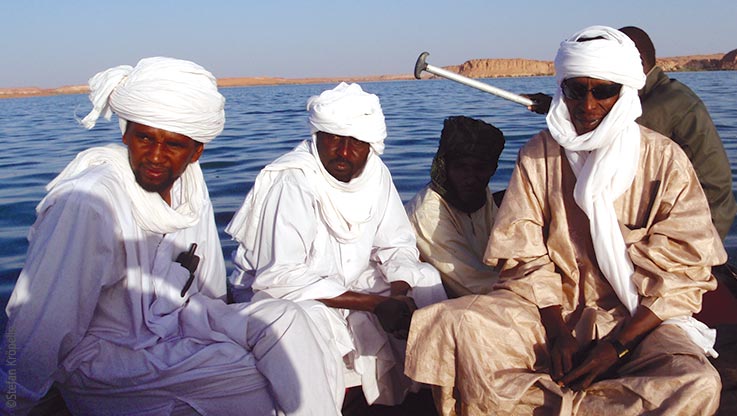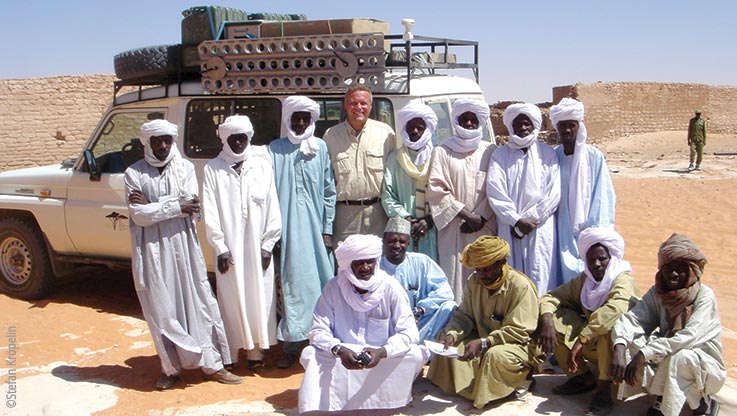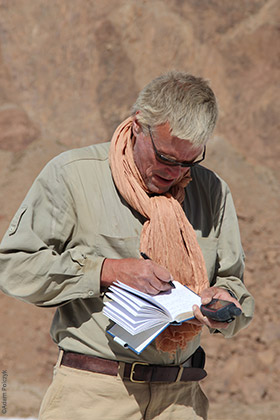
The lakeland area of Ounianga is worldwide unique, as the sediment houses the history of climate change over the last 10,500 years. It's not only that they tell us how it once was back then, which plants and animals existed, what natural disasters occurred and whether people had settled here - from the sediment left far above the current water level, scientists can read into the stages of climate change over millennia.
Stefan Kröpelin and his colleague Kollege Baba Mallaye are one in their mission: To explore the history of the lakes and to protect and preserve them for the rest of humanity.
For this reason there are regular expeditions to Ounianga lead by Stefan Kröpelin. He and his five to ten strong team - from different corners of the world and different specialist areas - will spend weeks at a time here investigating climate change. For this they take samples and extract sediment cores of up to 16 metres long from the old lake-beds.
In his diary, Stefan Kröpelin captures a record of his experiences and impressions along the way. Read with us and learn more about the physical and logistical challenges of these expeditions in the middle of the desert, with no access to electricity, water, telephone or medical supplies.
Chad receives us again
Cologne – Paris - N’Djamena. 2 changes and a journey time of 10 hours. Each of us carrying 50 kilos of our own personal luggage, not to mention the many cases of equipment adding hundreds of kilos more. Finally!
Arrival in the Chadian capital of N’Djamena, after intense weeks of preparation. It's hot. 40 degrees air temperature and 30% humidity.
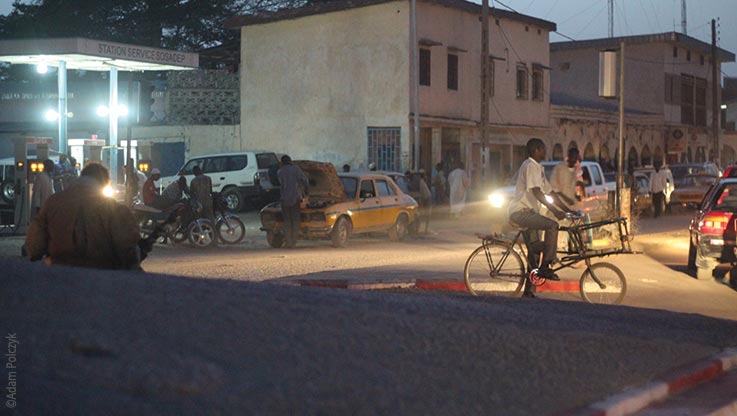
Official engagements
As always my friend and colleague picks us up and takes us to the hotel. For the coming weeks, these will be the last chances to have a shower and the last nights in a bed. Just one week left to finish all preparations, and a few official engagements to take care of.
What awaits us on this expedition? Will things all go to plan? Lots going through my head right now. Tension is growing, and I'm very happy to be back here again.
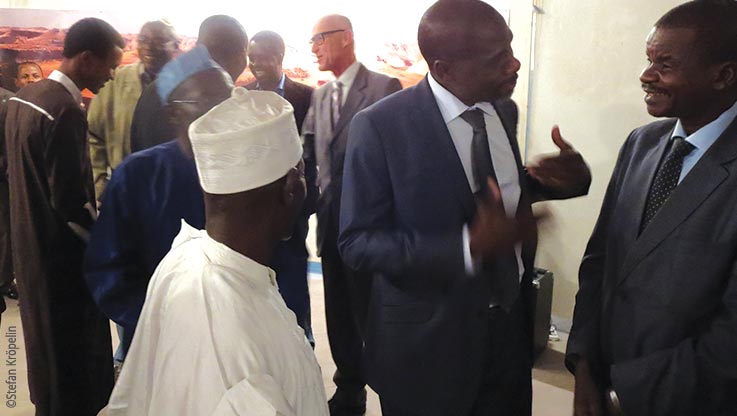
Shopping and packing
Organising an expedition takes a great deal of preparation. What is needed for six weeks of research in the desert? Provisions for the crew, medication, thousands of litres of fuel, hundreds of litres of drinking water, satellite equipment, computers, measuring instruments, spare tyres and inner tubes, spare parts... the list long! Everything has to fit packed into or on the roofs of the Jeeps. In the weeks to come shopping will be no more. What we forget now will be missing for the whole trip.
The moment you set off is the most beautiful moment.
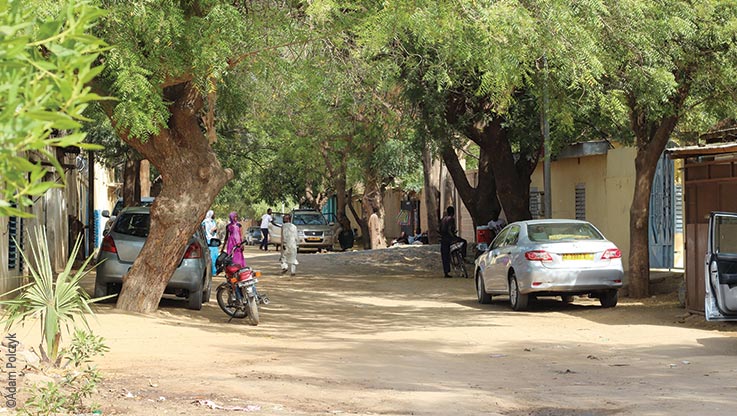
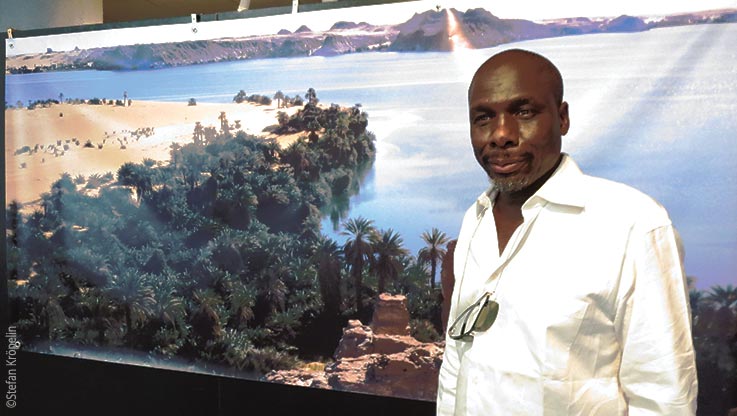

The last coke
Thousands of kilometres lie before us. Of these only a few hundred on paved roads. At first we're travelling along dirt roads. People, camels and donkeys often in the middle of the road. Dust whirling up, strongly obscuring our vision. Too dangerous! We choose to drive alongside the track. The journey is more difficult and longer, but at least safer. Two, three villages we cross. In the last bigger village we enjoy one last, lukewarm coke.
In no-man's-land
Not a trace of even a dirt track in sight. We drive over dunes, forever getting stuck in the sand. Up to 30 times a day we're having to dig our vehicles free. In temperatures of over 50 degrees, that's a real feat of physical effort. The journey is tough, but also fascinating - the landscape untouched. Signs of people here are as good as gone.
Heat and dust
In this deserted place, we can now only rely on ourselves. For some the heat is the biggest challenge. My biggest worry, though, is if one of us were to become seriously ill or get injured. Getting help now is as good as impossible. It would take days.
My motto: if we all get back healthy, it was a successful expedition - hopefully it's the case again this time!

Toumaï or: Where our forefathers once lived
Almost inconceivable: thousands of years ago humans actually lived here. Even harder to believe is that in this place lies the cradle of humanity. One of our oldest ancestors, "Toumaï", as he was named, from the now extinct species of the Sahelanthropus tchadensis (the Sahel people of Chad) - originated from here. He lived over 7.5 million years ago.
Toumaï means "Hope of life". Would he have been pleased with his name? What things did he think about, and what could his life have been like? Will we ever know this?
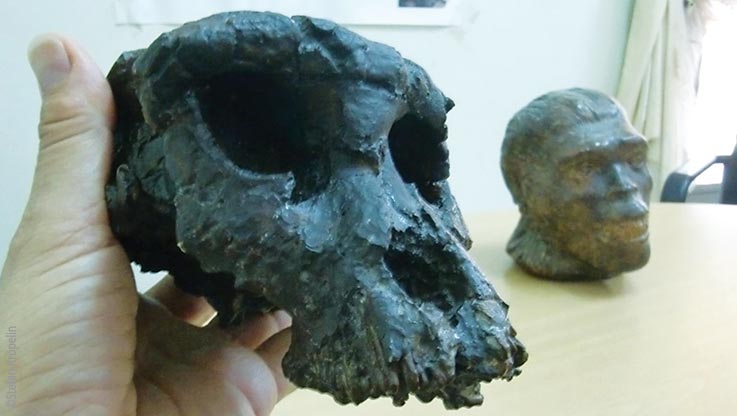
An adventurous journey
We often can't tell before exactly which course to take. The GPS gives us the beeline, but whether this way is in any way drivable, we just have to try. Sometimes we can neither go forward nor back. Creativity is required! We build bridges to get over narrow passes. When crossing dunes, the utmost of caution is needed to make sure the vehicles don't roll over. If an axel breaks, or the gearbox breaks, the expedition is as good as over. In comparison to that, punctures are a trivial matter.

When the sparks fly
After 7 hours of driving we hit a sandstorm. We are forced to stop and set up camp. That's no big deal for us, laughing and joking. The sand is everywhere; in the eyes, hair and clothes. You can basically forget trying to eat. By being constantly bombarded by millions of grains of sand, you're soon so highly charged with static that you get a hefty bolt of electricity every time you come in contact with another person or vehicle. You stop wanting to touch anything for fear of the sparks flying.
After the storm is before the storm
The next morning: the storm has retreated.
6 am breakfast. We are sitting on a large mat, everyone has their own cutlery. Our cook has been baking, tea and coffee has been brewed. What luxury! The sun is rising ever higher. We leave - goalwards.
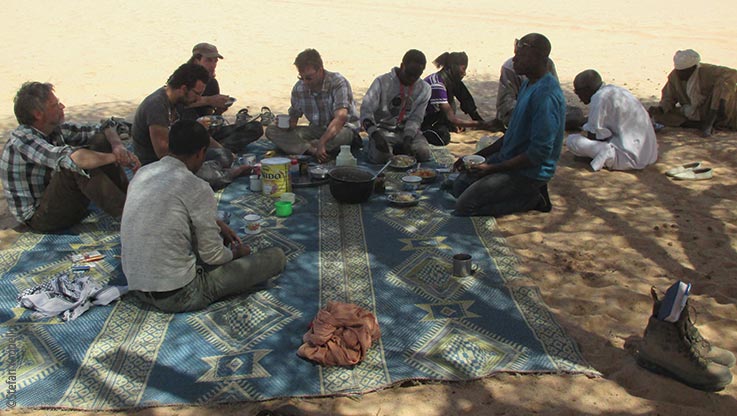
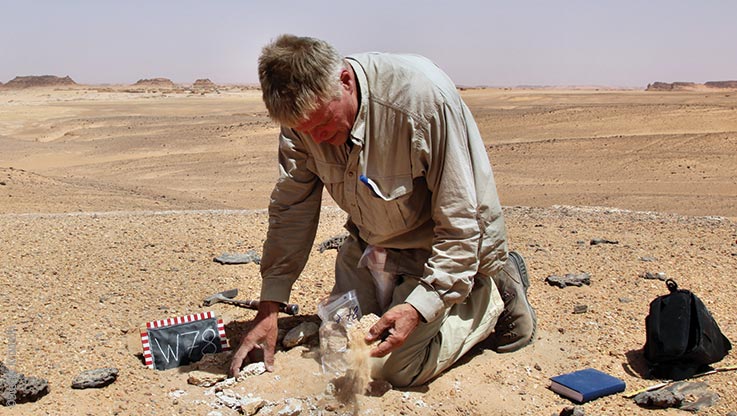


In paradise
Take a deep breath! Finally we've arrived! Finally we're in Ounianga! A blue paradise of water, a few huts and thousands of date palm trees appear. A fairy tale oasis in the middle of the desert. There, where every puddle dries out instantly, lakes survive made of 5,000-10,000 year old rain water. The lakes really are a wonder of nature.
One who doesn't know the Lakes of Ounianga, does not know the Sahara.
Green island
There is a thin strip of fertile land around the edge of the Ounianga lakes. The people living here plant fruit and vegetable gardens there. The most important staple here, though, is the date.
The tranquil life in the oasis is in stark contrast to the raw desert conditions outside of it. Everytime we receive gifts of dates and vegetables. Sometimes we even take it upon ourselves to buy a goat from them.
The joy of reunion
It's such a nice feeling to see old friends again. It's been years since we were last here. We meet the locals and tell them all about our research findings. We are so warmly received, drink tea together and eat delicious date purée.
Time to set up camp before the night falls! We pile cases up on top of each other and create a barricade. They'll serve us over the coming weeks as the place to sleep, sheltering us from the constant wind. Our kitchen gets pride of place. We collect firewood and cook.
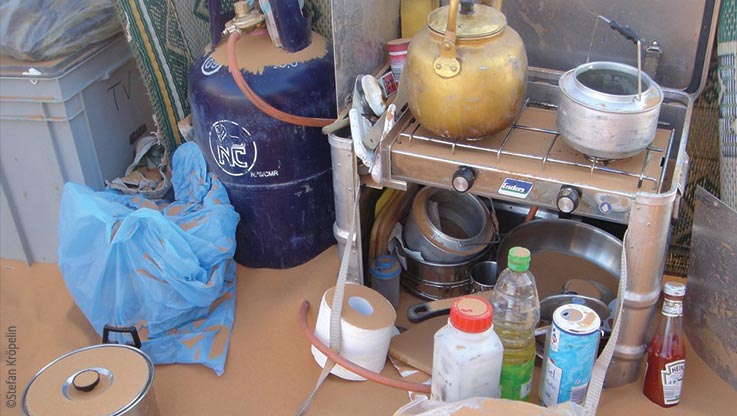

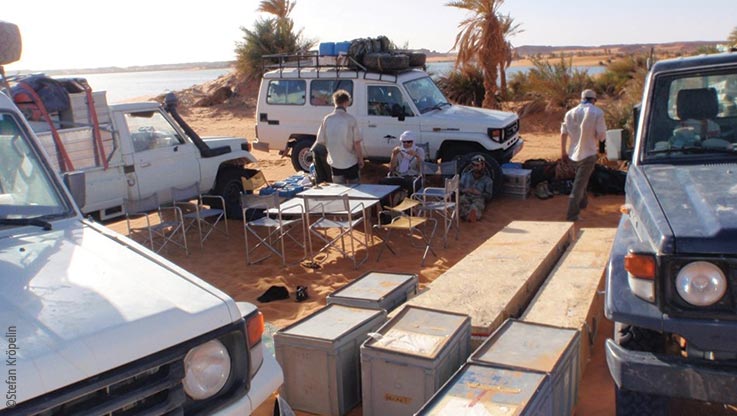
Constructing the platform
6:00 a.m. get up. 5 degrees Celsius - time to get out of the sleeping bag. It's bitterly cold. Everything has to be rid of the copious amounts of sand. I pack my stuff together: tent, sleeping bag, tissues, knife, lamp, lighter.. it's 60 kilos of baggage I lug back to the camp. We all have breakfast together. Hot tea and bread. The bread is full of sand - it crunches between the teeth. Whatever. The main thing is that the wind has gone and we can work. Sunrise.

10 m² on the lake
Up to the lake! At the water's edge we put together the floating platform, pump up the rubber dinghies and tank up the engines with diesel. All hands on deck. The platform is up! 10m² is the size of our floating work station. This is where we'll be spending the next days. For weeks we've been waiting for this moment.
We load on the tools: heavy boring rods, marker pens, gloves, notebook, camera, measuring instruments, sun cream, food supplies, a lot of drinking water, cling film as packaging... and set off out onto the lake. A great feeling!
16 metres in 10 days
We're standing on the platform. The wind is calm - we're in luck! Ounianga is one of the windiest areas of the Sahara! In strong winds the platform rocks a great deal. It's lifted up and then pushed deep into the water. Work then is impossible and too dangerous. Also the drill core can be ripped out. Something like that happened before - the steel cable snapped and we lost the drill core. Days of arduous work for nothing.

Millimetre by millimetre
We've taken on a lot on this expedition! We want to extract a 16 metre long drill core in 10 days. We ready ourselves, take a sip of water and get to work. Blow by blow we drive the drill core deeper into the seabed. Each hit drives the core only millimetres into the solid earth. The hammer weighs 30 kilos. It takes at least 300 hits to barely get one metre down. It's very hot. The platform is wobbling. The water is reflecting the sun. We manage on average of 30, 40, 50, hits in a row. My record; 100 hits! The team work to the point of total exhaustion.
Our valuable goods
Enough for today. We ride back to the water's edge. Despite the exhaustion we must be careful when getting out. If the boat tips over, the drill and the equipment will fall into the water. Once out we still have to carry the drill core up the steep sand banks. The problem there; you take one step up while slipping straight back down. We lug the drill itself to the nearest fresh water lake to clean it of the salt and mud.
We freshen up ourselves too, in the cool water. Heaven! Suddenly a swarm of mosquitos rain down on us - we flee.
Evening
Every muscle is aching, some of us have sunburn. Now it's relaxing, eating, reading, writing the diary. Indescribably beautiful starry night sky. I sleep on the floor, away from the camp. Others prefer to use the camp beds. I enjoy the silence, think of home. I make a quick call on the satellite phone. Back when this possibility didn't exist I would have to go months with no contact at all. That wasn't easy. Into my sleeping bag and I'm gone! Tomorrow awaits with a new, hard-working day.
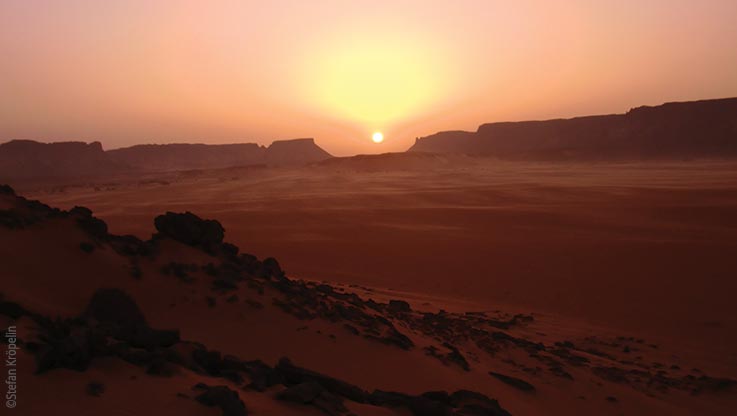
Hammering and drilling
A new day breaks in Ounianga. Roll up the thermo-mat, squeeze out the air, sleeping bag, mosquito net, thermal vest, mosquito repellant, everything that was needed during the night has to be packed away. The entire household has to be packed away. Breakfast.
We'll be hammering and drilling the whole day. This is how the next few days will be. After the expedition we won't be needing the gym anymore.
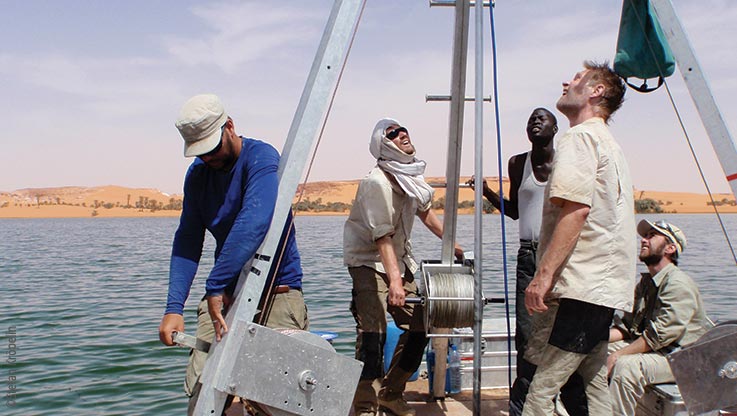
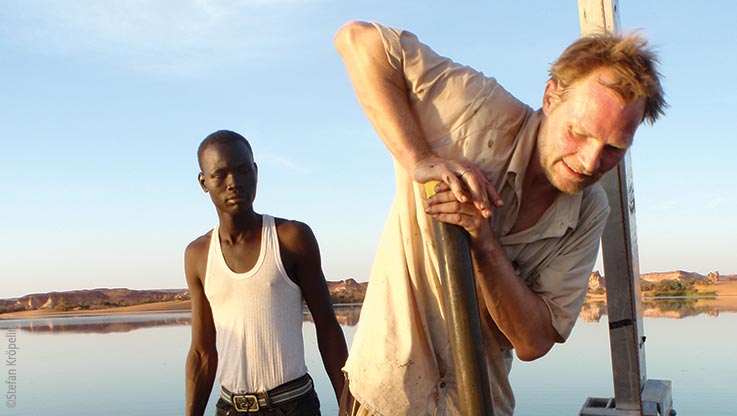
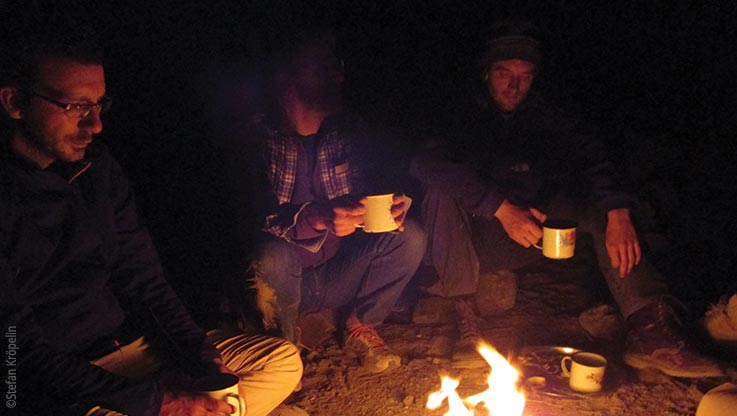
Investigating the land
The work on the platform is done. We have a 16 metre long drill core - something no one before has ever achieved.
As of today we're exploring the Ounianga Serir area. There are more left-over lake deposits here. About 9,000 years ago these lakes were almost 80 metres higher. Due to a fall in water levels, the lake-beds are now at the surface. We take samples - they are much easier to access than the ones out in the deep lakes.
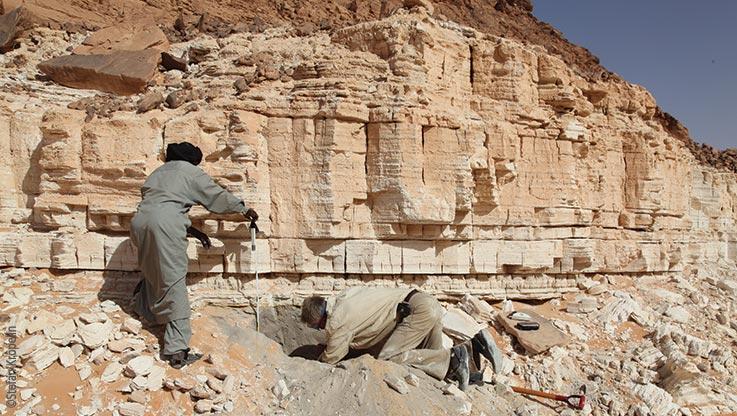
Nighttime in the desert
Most are already asleep. Suddenly a noise in the middle of the night and a clatter of cutlery. We switch on our torches - a desert fox! It's eating its way through the kitchen box. Cheeky blighter.
As always, I take a little walk through the night. Sometimes I find cave drawings and prehistoric tombs. I note it all down in my book. It's late! I follow my GPS to back to my tent. I write my diary and treat myself to a piece of chocolate. During the day it's melted and runny, but in the meantime it's solidified again.
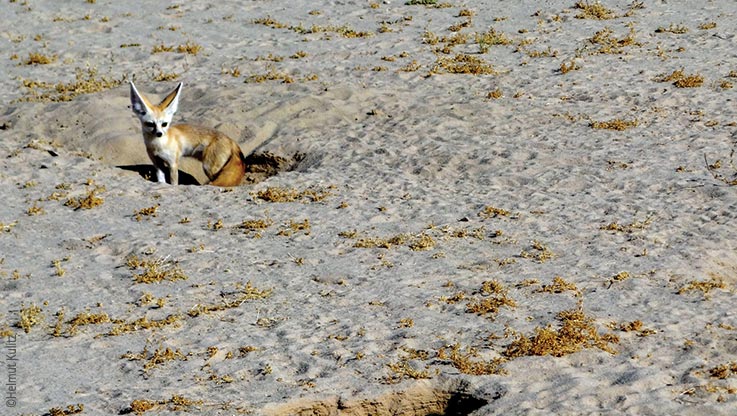
Taking records
Our botanist is gathering plants. At the same time we're measuring, mapping, photographing and finishing off sketches of the surroundings. We note down GPS data for spots of geological and archeological interest. Making notes at the same time is important to be able to make sense of and organise all of the material later. There's so much more to explore. Hopefully we can come back next year.
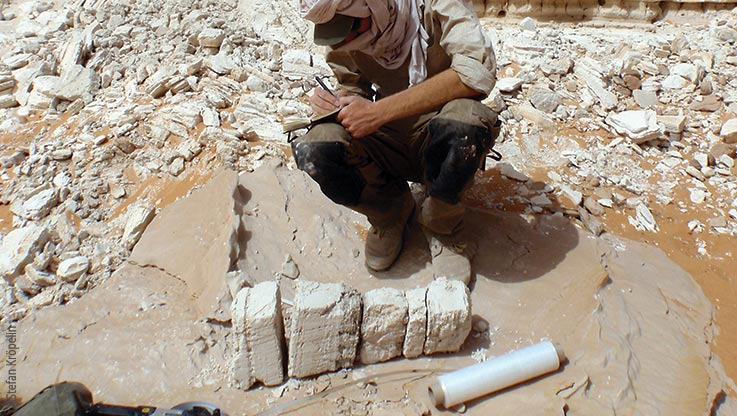
A stormy farewell
Today we also take notes the whole day. Around lunchtime: sandstorm! We can't work anymore. Quickly put on the ski goggles and some cloth over the mouth. Secure everything and mount the wind protectors on the tent. Everything that isn't held down firmly will be blown away and lost in the desert forever. Sleeping bags, books, tents, I've seen them all fly off into the desert. Running after them is pointless, the winds are too strong. Even with the storm-proof lighter, we couldn't start a fire. Hopefully the storm will ease up by tomorrow so that we're able to pack.
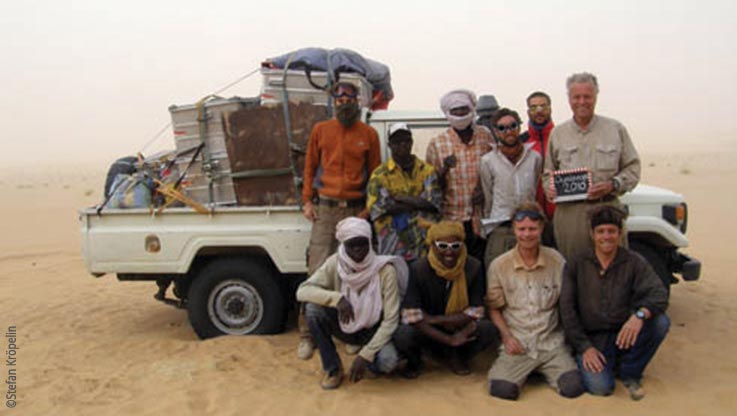
Packing and leaving for home
14 days in Ounianga are over! No it's time to pack and say our goodbyes. We pack everything away into the Jeeps and lift the cases onto the roofs. We take extra care to secure the drill core. We bid farewell to our friends.
A successful, intense time behind us, and an exciting trip home in front of us. A wave of melancholy hits me, there's so much more to explore. Nevertheless, today I'm looking forward to home, to my family, a long shower and a cool drink.
